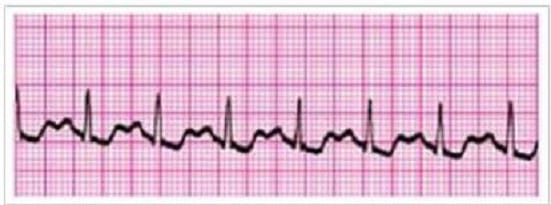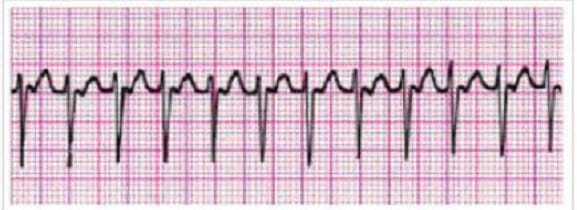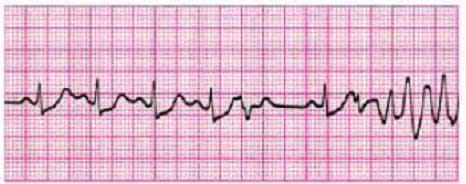Exam Details
Exam Code
:ACLSExam Name
:Advanced Cardiac Life SupportCertification
:Test Prep CertificationsVendor
:Test PrepTotal Questions
:301 Q&AsLast Updated
:Apr 11, 2025
Test Prep Test Prep Certifications ACLS Questions & Answers
-
Question 171:
Which of the following patients require intubation? (Choose two.)
A. conscious with a suspected stroke
B. unconscious with no gag reflex
C. normotensive with third degree heart block
D. cardiac arrest after three unsuccessful countershocks
-
Question 172:

Identify the rhythm by selecting the best single answer:
A. Normal sinus rhythm
B. Sinus tachycardia
C. Sinus bradycardia
D. Reentry supraventricular tachycardia
E. First-degree AV Block
F. Second-degree AV Block (Mobitz 1 Wenckebach)
G. Second-degree AV Block (Mobitz II Block)
H. Third-degree AV Block
I. Atrial fibrillation
J. Atrial flutter
K. Monomorphic ventricular tachycardia
L. Polymorphic ventricular tachycardia
M. Coarse ventricular fibrillation N. Fine ventricular fibrillation
O. Agonal rhythm/asystole
P. Pulseless electrical activity
-
Question 173:
T/F: Two rescuers using the bag-valve-mask will be more effective than one.
A. True
B. False
-
Question 174:
T/F: Position self at the side of the patient's head for optimal performance.
A. True
B. False
-
Question 175:

Identify the rhythm by selecting the best single answer:
A. Normal sinus rhythm
B. Sinus tachycardia
C. Sinus bradycardia
D. Reentry supraventricular tachycardia
E. First-degree AV Block
F. Second-degree AV Block (Mobitz 1 Wenckebach)
G. Second-degree AV Block (Mobitz II Block)
H. Third-degree AV Block
I. Atrial fibrillation
J. Atrial flutter
K. Monomorphic ventricular tachycardia
L. Polymorphic ventricular tachycardia
M. Coarse ventricular fibrillation
N. Fine ventricular fibrillation
O. Agonal rhythm/asystole
P. Pulseless electrical activity
-
Question 176:

Identify the rhythm by selecting the best single answer:
A. Normal sinus rhythm
B. Sinus tachycardia
C. Sinus bradycardia
D. Reentry supraventricular tachycardia
E. First-degree AV Block
F. Second-degree AV Block (Mobitz 1 Wenckebach)
G. Second-degree AV Block (Mobitz II Block)
H. Third-degree AV Block
I. Atrial fibrillation J. Atrial flutter
K. Monomorphic ventricular tachycardia
L. Polymorphic ventricular tachycardia
M. Coarse ventricular fibrillation
N. Fine ventricular fibrillation
O. Agonal rhythm/asystole
P. Pulseless electrical activity
-
Question 177:
T/F: In order for there to be a duty to act, a contractual or legal obligation must exist.
A. True
B. False
-
Question 178:
T/F: A patient has the right to refuse treatment, even when that treatment may prove lifesaving.
A. True
B. False
-
Question 179:
T/F: Before leaving the scene of a patient who refuses transport, you should try to persuade the patient to be transported.
A. True
B. False
-
Question 180:
T/F: The patient does not have the right to refuse resuscitative orders.
A. True
B. False
Related Exams:
AACD
American Academy of Cosmetic DentistryACLS
Advanced Cardiac Life SupportASSET
ASSET Short Placement Tests Developed by ACTASSET-TEST
ASSET Short Placement Tests Developed by ACTBUSINESS-ENVIRONMENT-AND-CONCEPTS
Certified Public Accountant (Business Environment amd Concepts)CBEST-SECTION-1
California Basic Educational Skills Test - MathCBEST-SECTION-2
California Basic Educational Skills Test - ReadingCCE-CCC
Certified Cost Consultant / Cost Engineer (AACE International)CGFM
Certified Government Financial ManagerCGFNS
Commission on Graduates of Foreign Nursing Schools
Tips on How to Prepare for the Exams
Nowadays, the certification exams become more and more important and required by more and more enterprises when applying for a job. But how to prepare for the exam effectively? How to prepare for the exam in a short time with less efforts? How to get a ideal result and how to find the most reliable resources? Here on Vcedump.com, you will find all the answers. Vcedump.com provide not only Test Prep exam questions, answers and explanations but also complete assistance on your exam preparation and certification application. If you are confused on your ACLS exam preparations and Test Prep certification application, do not hesitate to visit our Vcedump.com to find your solutions here.